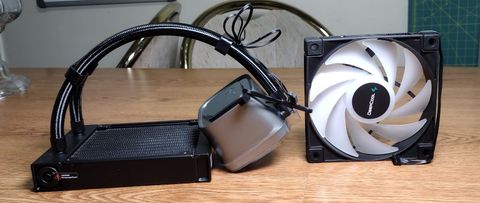Tom's Hardware Verdict
DeepCool’s LS320 is capable of cooling over 140W with Alder Lake CPUs, but it can’t handle an i9-12900K without enforcing power limits. It’s best paired with CPUs like Intel’s i7-12700 or Ryzen 5800X.
Pros
- +
Compact 120mm size for SFF builds
- +
Capable of cooling over 140W comfortably with Alder Lake CPUs
- +
Unique fan connection system
- +
User Customizable Face Plate
Cons
- -
No software for lighting, fan controls
- -
High price compared to overall performance
Why you can trust Tom's Hardware
DeepCool was founded in Beijing in 1996 and has earned a solid reputation in the CPU Cooler space with options like the Assassin III and AK620, considered to be some of the best air coolers on the market. The company’s lineup includes both air and AIO coolers as well as computer cases, keyboards, power supplies and other accessories.
While most AIOs on the market are based on Asetek designs, DeepCool is one of the few companies which makes its own, in-house, pump designs. DeepCool sent us the new LS320, a 120mm AIO liquid cooler featuring its latest generation in-house design, and the cooler retails for $89.99.
In the past I’ve generally avoided 120mm AIOs due to their typically limited cooling potential. However, we previously tested the larger 240mm LS520 cooler and were impressed by how well it handled Intel’s Core i9-12900K. That made me wonder: Is the LS320’s redesigned pump system enough to overcome the disadvantages of a smaller radiator and earn a spot on our best AIO coolers list? We’ll have to put it through testing to find out. But first here are the specifications from DeepCool.

Specifications for the DeepCool LS520
| Cooler | DeepCool LS320 |
| MSRP | $89.99 USD |
| Radiator Dimensions | 159 × 120 × 27 mm |
| Net Weight | 1003g |
| Socket Compatibility | Intel Socket LGA 115X / 1200 / 1700 / 2011 / 2066 |
| AMD AM4 / AM5 | |
| Rated Noise Level | Up to 32.9 dBA |
| CPU Block | Copper |
| Row 8 - Cell 0 |
Packing and Included Contents
DeepCool’s LS320 ships in a small, almost square box, packed with molded cardboard and soft plastic coverings of the individual parts for protection.

Included with the package are the following:
- CPU Block and Radiator
- 1x FC120 120mm fan
- Mounts for all modern CPU sockets, including LGA1700, TR4, and AM4/AM5 motherboards
- Customizable blank plate for CPU block
- Manual & support pamphlets
- 2x coolant line clips
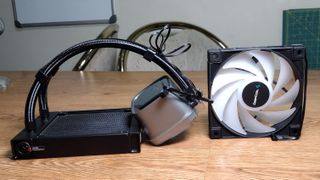
Cooler Installation
Installing the DeepCool’s LS320 was fairly easy. To begin, you’ll first want to secure the radiator to your case. And with these small 120mm AIOs, the radiator often gets mounted in the case’s rear exhaust, though we mounted at the top for comparison to larger coolers. For more about radiator and fan placement, see our PC airflow guide. After the radiator and fan are mounted, press the backplate against the motherboard and mount the stand-offs. You won’t need to worry about thermal paste, as it is pre-applied to the CPU block here. Press the CPU block against the standoffs, and then use the included thumb screws to secure it.


New Testing Configuration
| Cooler | DeepCool LS320, 120mm AIO |
| Comparison Coolers Tested | BeQuiet Pure Loop 2 FX, 360mm AIO |
| Cooler Master Master Liquid PL360 Flux 360mm AIO | |
| Row 3 - Cell 0 | Cooler Master Master Liquid PL240 Flux, 240mm AIO |
| Cougar Forza 85 Air Cooler | |
| Cougar Poseidon GT 360, 360m AIO | |
| Corsair iCUE H100i Elite 240mm AIO | |
| Row 7 - Cell 0 | DeepCool AK500, air cooler |
| DeepCool LS520, 240mm AIO | |
| CPU | Intel i9-12900K |
| Motherboard | MSI z690 A-Pro DDR4 |
| Case | BeQuiet! Silent Base 802 Window |
| PSU | DeepCool PQ1000M |
What's different than other coolers?
Latest in-house pump design from DeepCool
The vast majority of Liquid Coolers on the market today are based around Asetek designs, with pumps integrated into the CPU block. But the LS520 incorporates the latest generation in-house design from DeepCool.
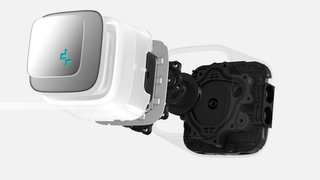
User Customizable Plate
Included with the LS320 is a blank CPU block plate, which lets you create your own design for the RGB-lit CPU block. Given that most companies just slap their logo here and give you no other options, this is a nice touch.
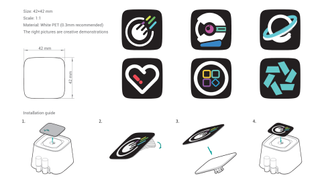
Custom DeepCool FC120 fan
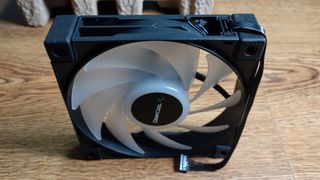
The LS320 includes DeepCool’s FC120 fan, sporting a unique fan connection system which allows for easy daisy-chaining of both fan & lighting controls in a single cable. The FC120 fans are a stronger SKU than the company’s retail models and feature upgraded airflow and static pressure as a result of higher maximum fan speeds. These fans include arrows on the sides indicating both the directions that the fans spin as well as the direction of the airflow.

| Model | FC120 |
| Dimensions | 120 x 120 x 25 mm |
| Fan Speed | 500-2250 RPM±10% |
| Air Flow | 82.48 CFM ± 10% |
| Air Pressure | 3.27 mmAq |
| Noise Level | Up to 32.9 dB(A) |
| Lighting | ARGB |
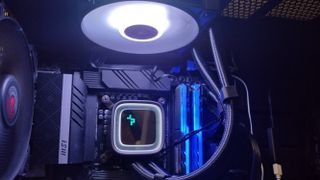
As with other recent AIOs, I'll be testing DeepCool’s LS320 with Intel's Core i9-12900K. Due to the increased thermal density of the Intel 7 manufacturing process, as well as changes to core and component layouts, Alder Lake CPUs are more difficult to cool than previous generation CPUs in the most heat-intensive of workloads.
This means that coolers that kept previous generation products like the i9-10900K nice and cool sometimes struggle to keep Intel's i9-12900K under TJ max–the top temperature before the CPU starts to throttle. Many coolers, including DeepCool’s last generation Castle EX AIOs, failed to keep the i9-12900K under TJ max when power limits are removed in workloads like Cinebench and OCCT when I’ve tested them.
Please note there are many factors other than the CPU cooler that can influence your cooling performance. A system's motherboard can especially influence this, as there are boards on the market with CPU sockets that aren't up to Intel's spec, which can cause warping or poor contact with the CPU. The case you use will also influence cooling results.
With Alder Lake's cooling demands in mind, I'll be rating CPU Coolers in 3 different tiers.
Tier 1: These coolers are able to keep the i9-12900K below TJ max in most loads, with no power limits enforced. I expect only the best liquid coolers to meet this standard.
Tier 2: These coolers are able to keep the i9-12900K under the TJ max threshold with CPU power limits of 200W enforced. I expect most liquid coolers and the best air coolers to meet this standard.
Tier 3: These coolers are able to keep the i9-12900K under TJ max with CPU power limits of 140W enforced.
Testing Methodology
To test the limits of a cooler's thermal dissipation capabilities, I run two primary stress tests: Cinebench and OCCT each for 10 minutes. While this may be a short amount of time, it is sufficient to push most coolers–air and liquid–to their limits.
While stress testing in Cinebench, I run both with power limits removed and with an enforced 200W CPU power limit. In this test setup using MSI’s z690 A Pro DDR4 Motherboard and Be Quiet’s Silent Base 802 Computer Case. Only the best coolers are able to pass Cinebench testing when power limits are removed.
I don’t test OCCT without power limits because attempting to do so results in CPU package power consumption jumping to over 270W and instantly throttling with even the best AIO coolers. Instead, I test at 200W to give coolers a chance at passing. I also include 140W results to give data closer to a lower-end CPU, such as AMD’s Ryzen 5600X or Intel’s i5-12400.

Albert Thomas is a contributor for Tom’s Hardware, primarily covering CPU cooling reviews.
